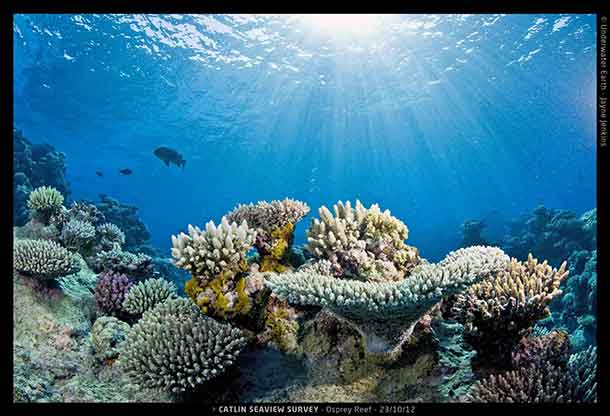

CREDIT: Jayne Jenkins, Catlin Seaview Survey
Using ecosystems to buffer against extreme events like hurricanes and storm surges could generate cost-savings of “billions if not trillions” of dollars
By Sophie Hares
TEPIC, Mexico (Thomson Reuters Foundation) – Twice a week, fisherman Romould Compton puts on scuba gear to dive to the seabed and clean tiny elkhorns growing in the coral nursery off the Caribbean island of Carriacou, tending them until they can be transplanted to a damaged reef nearby.
He hopes his conservation work will help to bring back more of the fish, such as red snapper, king butterfish and hind, that many islanders depend on.
“In my area we depend on the reef for our survival and livelihoods, and a lot of reef is dead,” said Compton by phone from Windward, Carriacou, one of the lush, mountainous islands that make up Grenada in the southeast of the Caribbean.
“A lot of unemployment has been happening so we’ve got to turn to the sea to keep our livelihood going.”
Across the Caribbean, scores of projects are underway to restore battered coral reefs and replant damaged mangroves, crucial to livelihoods from fishing and income from the millions of tourists who flock to the tropical beaches each year.
The intricate reefs and salt-tolerant mangrove swamps also offer protection against storms and hurricanes on climate-vulnerable islands which often lack resources to build extensive engineered coastal defences.
Insurers are now looking closely at how ecosystems can help bolster coastal resilience, while high-tech models help determine how new hotels and infrastructure might impact the fragile ecological balance as well as local communities.
“When you talk to the prime minister of any country in the Caribbean, they absolutely recognise the path of climate change,” said Luis Solórzano, executive director of The Nature Conservancy’s (TNC) programme in the Caribbean, which is working to restore marine habitats.
“They’re also thinking, instead of providing assistance, what can we do to prevent, to try and minimise the expected damage of what we know is going to be an increasing frequency of extreme events,” he said.
Using ecosystems to help buffer against extreme events such as hurricanes and storm surges could generate cost-savings of “billions if not trillions” of dollars, he said.

CLIMATE RESISTANCE
At the Mote Marine Laboratory in Florida, scientists are trying to replicate the sea conditions they expect to see in 50 to 100 years to determine which corals are the hardiest, then cross strains to produce climate-resistant species that can be transplanted onto reefs across the Caribbean, said David Vaughan, who manages Mote’s reef restoration programme.
One of Vaughan’s most important discoveries came by chance: he accidentally shattered an elkhorn coral and found micro-fragmentation can cause it to grow up to 40 times faster.
“If people think climate change is just a theory, they should just look at that wonderful thermometer in the field that’s called corals and that’ll tell them differently,” said Vaughan, whose laboratory works with TNC and produces 1,000 corals a day, including bulbous brain and mountain corals.
He hopes the new coral “offspring” will be “better prepared in the future for whatever man or mother nature hands to them”.
The 63-year-old, who has vowed to plant a million corals by the time he retires, said Mote is planning a laboratory to train up to 50 people each week from around the world, who could eventually replicate its coral restoration project.
With that scale-up, “we could literally plant a billion corals around the world,” he said.
GETTING AHEAD
Alongside bringing in tourist dollars, healthy coral reefs, seagrasses and salt-tolerant mangroves provide habitats for many species that generate an income for fishermen – from spiny lobsters in Belize to bonefish in the Bahamas.
Reefs can also act like breakwaters to dramatically reduce wave strength, while mangroves can buffer against hurricane winds and storm surges.
Marine scientist Michael Beck calculates coral reefs can slash up to 97 percent of the wave energy that would otherwise hit the shoreline, while a 100-metre (330-ft) wide band of mangrove can cut wave height by up to two-thirds.
High-tech modelling is helping Caribbean governments bolster coastal resilience by demonstrating how development can affect coastal ecosystems, livelihoods and property, said Katie Arkema, lead scientist at the Natural Capital Project, which has used its technology in Belize and the low-lying islands of the Bahamas.
“What we seek to do is understand how will our decisions and the decisions of governments… affect ecosystems and how in turn will those ecosystem changes affect people,” said Arkema.
The World Bank, which is helping pilot a coastal insurance project offering reduced premiums to governments working to make the region’s over-exploited fisheries more resilient, said Jamaica, Grenada and St. Lucia were among those interested.
But pay-outs would likely hinge on countries agreeing to invest a slice of the money in marine habitats, he said.
“Increasingly, Caribbean governments are finding ways to make better use of their marine resources, (to) take advantage of their marine ecosystems, the natural assets that are so important to them,” said Miguel Angel Jorge, senior fisheries specialist with the World Bank.
“They want to be much smarter about how they invest and plan with the likely climate impacts in mind.”
In Grenville, Grenada, where many low-income families depend on fishing, efforts to boost coastal resilience were partly driven by the community – which is involved in projects to replant mangroves and establish an artificial reef, said Nealla Frederick, TNC’s Eastern Caribbean conservation planner.
“Just everybody has recognised this is happening and wants to try to get ahead of it,” she said.
(Reporting by Sophie Hares; editing by Ros Russell. Credit: Thomson Reuters Foundation, the charitable arm of Thomson Reuters, that covers humanitarian news, climate change, resilience, women’s rights, trafficking and property rights. Visit http://news.trust.org/climate)
The Thomson Reuters Foundation is reporting on resilience as part of its work on zilient.org, an online platform building a global network of people interested in resilience, in partnership with the Rockefeller Foundation.
